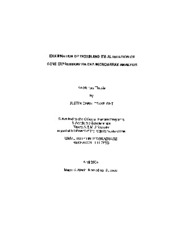| dc.description.abstract | Endocrine disruptive chemicals are known to produce harmful developmental effects on humans and other animals. Since substantial quantities of these chemicals are concentrated in the fat reserves of their victims, it is reasonable to expect a correlation between chemical concentration and physical effect before and to research further into the actuality of the EDCs effects. Some health hazards that are suspected to result from chemical exposure in humans are cleft lip and palate problems, feminization of male offspring, extreme premature puberty in female offspring, neural tube defects, autism, ototoxity, fetal alcohol syndrome (FAS), fetal tobacco syndrome (FTS), Type II diabetes also known as Non Insulin Dependent Diabetes Mellitus (NIDDM), and ADD/ADHD. Little evidence has been available to demonstrate how dioxin specifically alters gene expression, both in developing embryos and adults. Recently, Texas A&M University has acquired several DNA Microarray Systems, which are revolutionizing the examination of research into gene expression alterations. A new cell line of human embryonic kidney cells (293T/17 epithelial) have been properly cultured, had the RNA successfully isolated, and patterns were interpreted for genetic change using DNA Microarray Analysis. Through a cDNA slide specifically spotted with DNA of approximately 1200 endocrine regulated genes, the RNA of these cells can be examined using the DNA Microarray System after being exposed to different concentrations of dioxin, estradiol, DMSO, combinations of chemicals, and finally a control line of unexposed cells. Specific altered genes of the human embryo are predicted to be represented as changed in the RNA of cells previously exposed to dioxin. A nearly undetectable amount of dioxin (10⁴̄ M), was introduced to these cells, and produced significant variation from the natural gene expression. These data suggest that major advances in the prevention of physical pain and deformities in both developmental and everyday lives of both humans and animals could be attained by reducing exposure to environmental chemicals. The genes that are altered by the effects of TCDD promise further research, investigation, and prevention of many disruptive diseases. | en |


